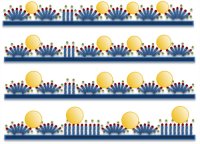Chemical & Materials Sciences Division
Research Highlights
September 2011
Creating Desirable Materials Requires Salt, But Not Space
Team answers fundamental questions about self-assembling designer metal oxides for batteries

The scientists found that nanoparticles grow between the dips in the hemicylindrical templates. However, if the particles outgrow the crevices, the template changes from mounds into a grass-like surface, allowing the particles to grow inconsistently, coalescing into larger clusters. Enlarge Image
Results: When synthesizing specialized materials for energy-packed batteries, the problem is the template. The pattern for self-assembling the highly desired nanometer-sized spheres falls apart, producing irregular metal oxide clumps. Scientists at Pacific Northwest National Laboratory determined how to keep the template intact. The answer is as simple as adding salt to the process.
Why It Matters: Electric vehicles and the nation's power grid would both benefit from energy-dense, long-lasting batteries. Electric vehicles could travel greater distances between charges. The power grid could tap into stored wind and solar energy. Such batteries require new materials with specific nanosized features. Unfortunately, designing these materials has been a process of trial and error. Scientists would prefer to design templates, mix together reactants, and allow the materials to assemble themselves. The problem is that the templates don't last. With the answers from this study, scientists can manufacture identical particles that are then assembled into battery electrodes.
"This research provides fundamental answers needed to produce high-quality, well-defined materials that will work as electrodes in lithium-ion batteries and next-generation lithium-air batteries," said Dr. Maria Sushko, a PNNL materials scientist who worked on the study with Dr. Jun Liu.
Methods: Drawing upon experimental research, the PNNL researchers conducted theoretical analysis on template stability for titanium dioxide and other metal oxide nanoparticle self-assembly. The analysis was a classical density functional theory, or cDFT, study.
The team examined the template, which consists of two parts. First, the base is a layer of well-defined, conductive graphene. The second part is a surfactant. The surfactant is a molecule defined by its "head" and "tail" chemistry. The head of the molecule is hydrophobic or "water fearing" and attaches to the graphene. The tail is hydrophilic and interacts with the solution containing the ingredients for forming the desired metal oxide particles. The surfactant forms small mounds on the graphene that act as a template for the nanoparticle formation.
"But unless the surfactants form a stable structure, the whole of what you're building falls apart," said Sushko.
The scientists discovered that key to template stability was introducing a salt, specifically doubly charged cations and singly charged anions, into the mix. Then, the team used this result to predict how titanium dioxide nanoparticles grow on the template. They found that the particles grow between the dips in the hemicylindrical templates. However, if the particles outgrow the crevices, the template changes from mounds into a smooth, grass-like surface. Then, the particles grow inconsistently, coalescing into larger clusters.
"If we use the results of this paper [published in the Journal of Physical Chemistry B], we can grow nanoparticles in the confined matter to create larger, uniformly sized nanoparticles of metal oxides, such as titanium dioxide, which is very important to creating the materials you need for electrodes for batteries," said Sushko.
What's Next: The team is working on an experiment-based study to develop a thorough understanding of self-assembly and nucleation processes involved in constructing nanocomposite materials. This upcoming study and others like it are needed to unravel the mysteries of self-assembly and allow scientists to control material synthesis.
Acknowledgments: The study of surfactant self-assembly in confined environment is supported by the U.S. Department of Energy, Office of Basic Energy Sciences, Materials Sciences and Engineering Division. The development of the cDFT software is supported by the Laboratory Directed Research and Development Program at PNNL. While EMSL resources were not used in this theoretical paper, experimental work was done at the national user facility to confirm the results, which will be published in a forthcoming paper.
Research Team: Maria Sushko and Jun Liu, PNNL
Reference: Sushko ML and J Liu. 2011. "Surfactant Two-Dimensional Self-Assembly under Confinement." Journal of Physical Chemistry B 115(15):4322-4328. DOI: 10.1021/jp2003497
